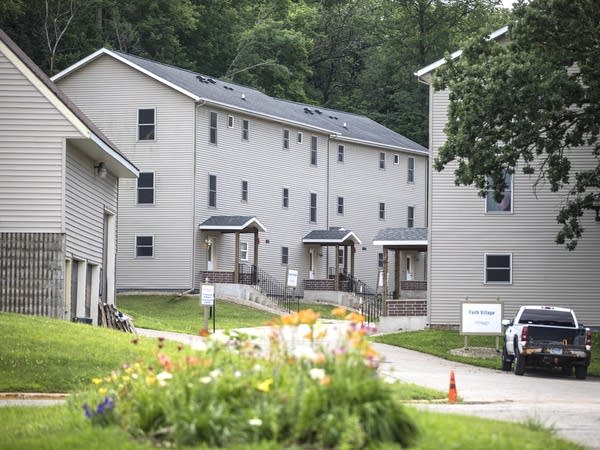Drive for low-cost housing finds bipartisan buy-in

Go Deeper.
Create an account or log in to save stories.
Like this?
Thanks for liking this story! We have added it to a list of your favorite stories.
Sandie Hayes found her way out of a homeless shelter and into one of 30-subsidized units in the Solace Apartments in St. Peter, Minn., in 2019.
The new setting provided the kind of housing stability her life was sorely missing. It helped Hayes escape a troubled relationship and aided in her pursuit of sobriety. She could easily tap into supportive services, including on-site Alcoholics Anonymous meetings and connection to mental health offerings.
“I’m alone now. I love myself. And I’m not in a toxic relationship anymore,” Hayes recounted recently. “If I didn’t have housing like Solace, that wouldn’t happen for me.”
Hayes shared those personal details with Minnesota lawmakers, who are searching for ways to replicate the success story.
Turn Up Your Support
MPR News helps you turn down the noise and build shared understanding. Turn up your support for this public resource and keep trusted journalism accessible to all.
Whether it’s people trying to get back on their feet or it’s companies struggling to expand because there are few places for workers to live, affordable housing is in critical demand.
Minnesota Housing, a state agency, estimated last year that more than 550,000 households devoted at least 30 percent of their income — sometimes much more — to housing. That benchmark is one measure of housing insecurity.
Rep. Alice Hausman, DFL-St. Paul and the chair of a legislative housing committee, said the problem has only grown more acute over the past year.
“Housing was already a crisis. It has become even greater since the pandemic and jobs that were lost and people who are one paycheck away from not being able to pay their bills,” Hausman said.
Sen. Rich Draheim, R-Madison Lake and head of a Senate housing panel, hears much the same.
“When I travel the state, that’s the number one thing I hear from chambers and business people is they don’t have enough affordable housing,” Draheim said. “They have a hard time attracting people because they can’t find anywhere that is affordable.”
A 2018 Housing Task Force estimated the need for 300,000 new housing units in Minnesota by 2030. While that figure covers all types and price points, the task force found the most significant need was for places where low-income families could call home.
Legislators from both parties are pushing bills to address the lagging stock of emergency shelter space, adequate multi-family housing at affordable rents and availability of entry-level, single-family homes.
Proposals range from increased assistance for rent or mortgage to state borrowing toward new housing development and building rehab projects.
Lawmakers are hearing from civic leaders, business owners and housing specialists from across the state — Alexandria, Grand Rapids, St. Peter and beyond. That’s probably by design.
Rep. Aisha Gomez, DFL-Minneapolis, said it highlights how substantial the statewide need is. She chairs a House committee focused on combating homelessness.
“Housing supply and affordability impact every single community across Minnesota,” Gomez said. “And I know we’re going to have to continue to beat that drum because there is this sort of mistaken impression that it just impacts the urban core.”
Take Roseau as an example.
Todd Peterson, community development coordinator in the far northwestern Minnesota city, said there are seldom vacancies in its affordable housing stock — a chronic problem that he says has made it tough for the industrial area to fill job openings.
“We just don’t have the housing to house those people we need to bring in to work at those jobs,” Peterson said. “We’ve tapped out our labor force and without additional housing we just can’t move forward.”
Dedicated workforce housing grants are among several proposals in the mix. Measures pushed by Gov. Tim Walz include $100 million in housing infrastructure bonds to foster more supportive housing, senior housing and manufactured home parks.
Since 2012, lawmakers have authorized $415 million in housing bonds that have supported $775 million in total development when local and private money is factored in. Housing Commissioner Jennifer Ho says the return on investment is strong.
“That’s jobs. That’s economic development. That’s getting people to work,” Ho said. “And it’s also creating or preserving over 4,700 units.”
Program skeptics say the cost-per-unit is too high.
The reasons are many: The prices of lumber and other construction supplies are up. There are permit fees that builders say drive up their costs. Many government-subsidized projects come with wage requirements for construction crews.
“We’re chasing perfection with the cost of building a new home or a new unit,” Draheim said.
He said the debate shouldn’t be limited to how much the state antes up.
“We have to look at zoning, energy code, building code, density,” he said.
The housing construction discussion could get tangled in the brewing debate over what to do about evictions once a COVID-19-prompted moratorium goes away.
Key lawmakers say they hope to keep the two separate, but that might not be possible as the session goes on.




